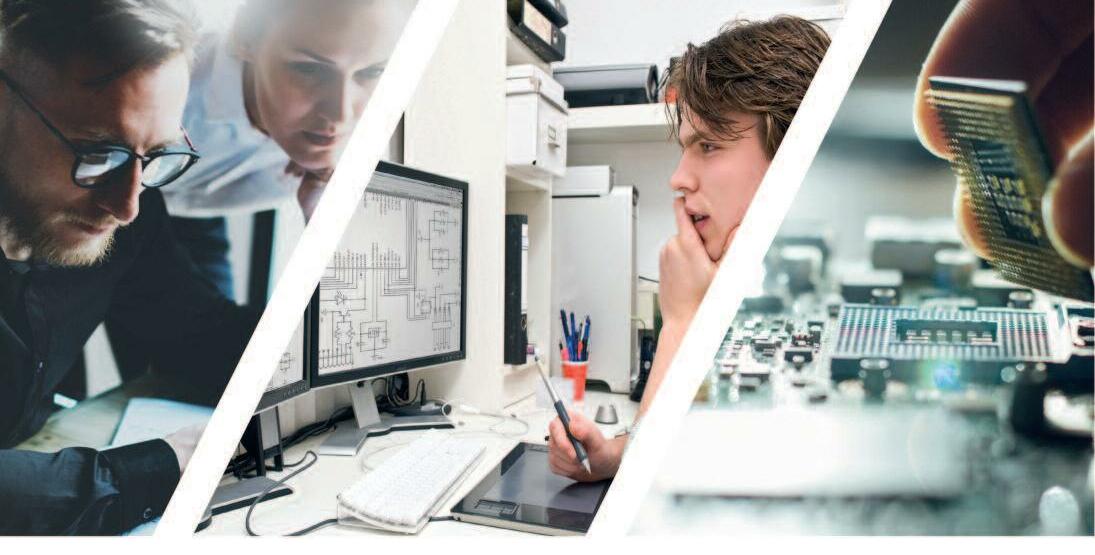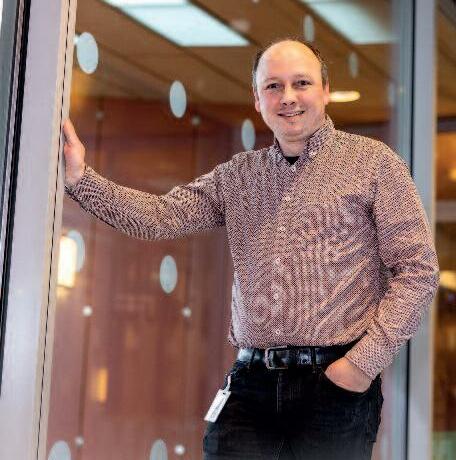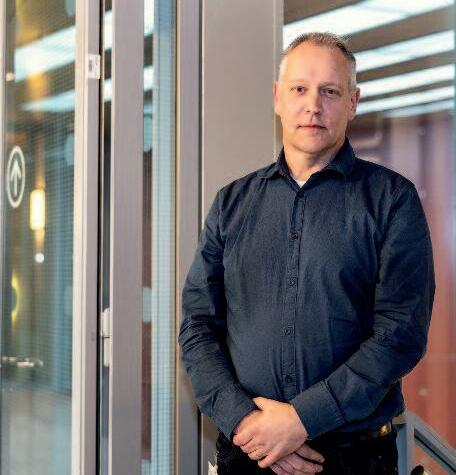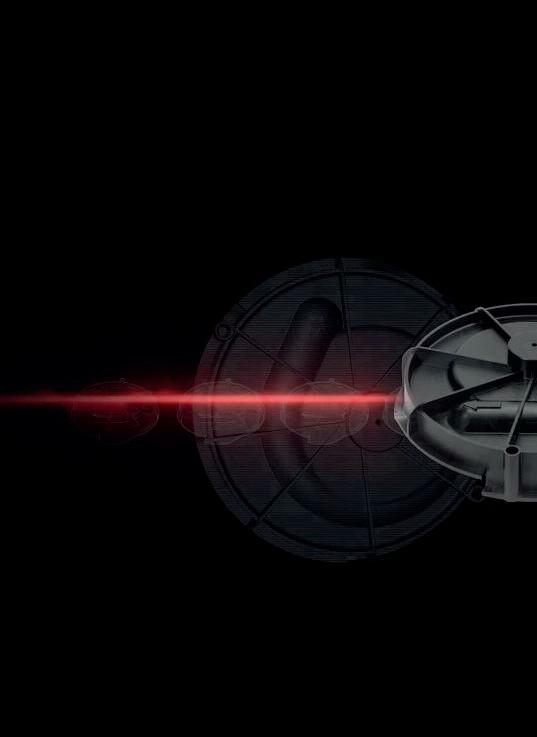
18 minute read
SERVITIZATION Philips and Thermo Fisher Scientific: increased turnover with digital services
BUSINESS MODEL IN THE SPOTLIGHT IN ‘SERVITIZATION: DESIGN FOR SERVICE’ WORKSHOP
PHILIPS AND THERMO FISHER SCIENTIFIC: INCREASED TURNOVER WITH DIGITAL SERVICES
Advertisement
The shift from selling products to service subscriptions is an important pillar in the servitization business model. Even for large companies like Philips and Thermo Fisher Scientific, the required digital transformation is still a major challenge. This emerged from their presentations during the ‘Servitization: Design for Service’ workshop at the High Tech Campus Eindhoven in late February. Organising the event was the European Supply Chain Forum of Eindhoven University of Technology in partnership with the Servitization Platform of Link Magazine. ‘This is not so much about operational excellence but about customer value. ’
At Thermo Fisher Scientific, the initial drive for servitization was making the lives of the field service engineers easier with smart tooling. Photo: Thermo Fisher Scientific
BY HANS VAN EERDEN
These days, Design for Service also falls under the term DfX (Design for X, in which X stands for manufacturing, assembly, etc.). So says Néomie Raassens of the European Supply Chain Forum when introducing the workshop. In this context, she says, service is primarily understood to mean the product plus the services that can be provided around it.
‘Most Design for Service methods are still mainly product-centred and not primarily focused on the user. That is to say, the user requirements are not included in the design from the start. ’ For that reason, this afternoon the focus is on designing/redesigning products with an eye to service delivery, providing services focused on the user, explains Raassens.
INTEGRATED SOLUTIONS
The first speaker is Marcel Boosten, lead architect for Philips Services, responsible for Design for Serviceability at Philips. ‘Our task is to help the business units with the in-design of serviceability in their products. The strategy of Philips as a healthcare company is to transform from a productbased business to a supplier of services and solutions. We supply more and more integrated solutions, combinations of products and services. ’ Those services are usually cloud-based, they often work remotely and they make use of big data and artificial intelligence (AI) in order to offer the customer smart solutions, for example for their performance improvement or predictive maintenance. ‘The trick is to combine human and artificial intelligence in order to take the best decisions. ’ Boosten cites the example of an integrated solution in the field of imageguided intervention. ‘Philips supplies the system along with the required catheters and the software for navigation during the intervention plus cathlab managed services; in this way, we are able to help the hospital manage their lab. XaaS, ‘ anything as a service ’ , is the underlying delivery model for this strategy. ’
CONTINUOUS IMPROVEMENT
By way of illustration, Boosten compares the ‘ old’ business model to a XaaS model from the customer perspective. Traditionally, the customer buys a system, for example a complex, expensive MRI or CT scanner, and uses it until end-of-life. ‘The customer draws up the requirements beforehand and then has to make the right procurement choice based on them. This comes with high capital costs and therefore a high entry threshold. The capabilities of the purchased solution are constant over its lifecycle and so, therefore, is the value the customer derives from its use. Added value can come from upgrades. These are often options that the customer decides not to buy initially, but at a later date. Typically, these options already exist at the time of sale. In the ‘ old’ business model, the user is responsible for realising that value. ’ On the other hand, in XaaS the customer does not have to make an expensive purchase but instead takes out a subscription to a service, so the entry threshold is low. The medical system, which remains the property of the supplier – Philips – functions as the platform for supplying the service. At the end of the subscription, Philips takes the system back in order to refurbish it (completely or as individual components) for a subsequent subscription round with the next customer. Payment for the service may be periodic or based on usage or even results (outcome). ‘We continue to innovate the service with new options ’ , explains Boosten.
that the apps on your smartphone regularly receive updates. That’ s the key to this model. Customers expect continuous improvement and are prepared to pay for the resulting increase in value over time. The supplier remains responsible for delivering that value – if they don ’t, the customer will not extend their subscription. ’
SUBSCRIBING TO A ROADMAP
Essentially, in a XaaS model customers are subscribing to an innovation roadmap, summarises Boosten. But do customers know what that roadmap is, asks one of the participants in the workshop. ‘Otherwise, they won ’t know what they ’ re paying for. ’ No, customers don ’t know the innovation roadmap, answers Boosten. ‘We don ’t make promises about which innovations we will be supplying in five years ’ time. We do promise that we will supply innovations and if we don ’t, of course customers can cancel their subscriptions. I expect that customers will above all look at our track record, the innovation we have delivered in recent years, and that they will base their faith in us on that. They are subscribing to our speed of innovation. In the case of an outcome-based service contract, we do make concrete promises, for example a, say, 30% improvement in efficiency over three years. Only if we deliver on that does the customer pay more. Obviously, that means we are taking on a lot of risk as a company. ’
The ‘Servitization: Design for Service’ workshop at the High Tech Campus Eindhoven was organised by the European Supply Chain Forum (ESCF) of Eindhoven University of Technology (TU/e) in partnership with Link Magazine’s Servitization Platform. Philips hosted the event and also gave one of the two presentations: ‘Designing for XaaS’ . The other presentation was delivered by Thermo Fisher Scientific, Materials and Structural Analysis division (formerly FEI): ‘Design for Digital Services’ . TU/e’s European Supply Chain Forum, which was created over 25 years ago, offers international companies an interactive platform and facilitates knowledge sharing, joint projects and research, with an emphasis on talent development and lifelong learning. One of the topical themes is servitization: the transition from selling products to supplying and maintaining product-service systems (service solutions). In 2020, the ESCF incorporated the Servitization Platform, which had been established by Link Magazine in 2017. Participating in the platform are ASML, Lely, Moba, VMI, Tembo Group, Spirotech, Vekoma, Group Schneider, Voortman Steel Group, Thermo Fisher Scientific and TU/e. The platform’s goal is to create broad awareness about the potential of servitization as an ‘enabler’ for continuity and profitable growth, with the pillars of (i) predictive maintenance, (ii) data-driven business models, and (iii) circular economy. The open platform offers market leaders the opportunity to share knowledge and work out concrete action plans. The coordination of the platform is in the hands of ESCF research director servitization Néomie Raassens (senior lecturer in servitization & innovation sourcing at TU/e) and network orchestrator John van Ginkel (publisher of Link Magazine).
•j.n.v.ginkel@tue.nl (information about platform) • • • • info@linkmagazine.nl www.escf.nl www.philips.com www.thermofisher.com
SWALLOW THE FISH
Speaking of risk, an interesting aspect of the model is that for Philips, its revenue shifts from a one-off purchase at the start to recurring revenue spread out across the subscription period. That means Philips has to foot the initial capital costs in one go,
TO BE CONTINUED ON PAGE 16
Cables and connectors Embedded computing Fibre optics Frequency control IoT and Wireless Magnetics Photonics and Imaging Power RF Semiconductors Sensors Test and Measurement

Consult. Design. Integrate.
Contact: Tel: +31(0)40 – 2507400 | Email: sales-nl@acalbfi.nl www.acalbfi.com/nl
whereas the future income flow is not guaranteed. A big OEM like Philips has the financial clout to do that, but smaller medical technology firms have problems with this ‘ swallow the fish’ model, as Eric Tigchelaar, head of Strategy and Business Development Services and Solutions at Philips, describes it. ‘If you switch to a service model, it means you have a big drop in turnover at the start. But you can more than earn it back. Research among listed companies has shown that if you implement this model successfully, your market value rises by 30% to 40%. ’ The model has been catching on in recent years, reports Boosten. ‘Many hospitals are still buying machines, but more and more of them are now asking for solutions. They don ’t want to connect everything up and manage it themselves any more. They recognise the value of optimising the total workflow based on an XaaS model. ’

DEVOPS
The XaaS model revolves around maximising the value that a service represents to the customer. That means Philips needs to know how the customer works and understand
what is of value to the customer (intimacy), provide the customer with valuable insights derived from the data gathered and finally make real improvements to its service that have value to the customer. ‘Really, you can summarise those three ‘i’ s ’ as customer value learning ’ , responds Ed Nijssen, TU/e professor of technology marketing. ‘The core is continuous monitoring and learning which current and new value is important for the customer in their business processes and which has still to be realised. ’ The (increasing) value is achieved by means of software-based services, so the development focus at Philips is on the software, in the familiar cycle of DevOps (Development –Operations): an endless round of improvements consisting of design, testing, operation and feedback, with releases coming in quick succession. This pertains to the application software. By contrast, the critical parts of the software (critical for business continuity, embedded control, real-time control and communication, and safety) and the hardware must remain outside this rapid cycle, because in these cases upgrades need to be thoroughly tested and, certainly for hardware, development takes much longer. ‘The hardware needs to be futureproof, that is to say it has to last for years before requiring a major update. ’ A good example is expanding the user interface to provide new functionality. Adding buttons to hardware is tricky and expensive, whereas adding buttons to a future-proof touchscreen is very simple.
CLINICAL INTERPRETATION
Finally, an interesting question relating to XaaS is whether ‘ anything ’ really does mean ‘ anything ’ . Because ultimately a hospital wants a diagnosis – so, is Philips going to start
supplying diagnoses as a service? ‘Radiology is not about images but about interpreting images ’ , says Boosten. ‘So, somewhere there needs to be a clinical team that interprets the images and it doesn ’t have to be in the hospital itself. ’ But the team won ’t be at Philips, adds Tigchelaar. ‘There is a big difference between evaluating technical quality and the clinical interpretation of an image. Philips has the technical skills, but not the diagnostic skills. That calls for a different kind of expertise and different arrangements on liability. For example, we can use AI to display particular highlights in an image and sell that as a service, or make correlations between data, in order to simplify decisionmaking. We supply clinical equipment but not clinical decision-making. ’
DATA TO INFORMATION
At Thermo Fisher Scientific, which develops and builds electron microscopes in Eindhoven, they also stay away from the images, in this case those captured by customers using their instruments. ‘These are IP-sensitive data; they are the property of the customer ’ , explains Joris ten Thije, programme manager Service Innovation. ‘For service purposes we only use the data from the instrument itself. Fortunately, we had defined the data models early on: this data is created during the customer ’ s process, this data is generated by our sensors in the device. ’ On this point, the positions of Philips and Thermo Fisher Scientific are the same. However, their journeys to servitization have been somewhat different, says Ten Thije. ‘In our case, it initially arose from the need to support the service organisation with information. It was simply a case of making the lives of the field service engineers easier with smart tooling. Five or six years ago we started using data to identify problems more quickly. Our electron microscopes are equipped with many different sensors, but our service engineers haven ’t got the time nor
Marcel Boosten, lead architect for Philips Services: ‘In a XaaS model, customers are subscribing to an innovation roadmap. ’ Photos, unless otherwise stated: Vincent Knoops

the possibilities to perform extensive data analyses. So, we started developing algorithms that turn the raw data into comprehensible, directly interpretable information or generate an alert if a particular value falls outside preset limits. We call this Data to information, and what it yields is a kind of status and health indicator for our devices. ’
UPTIME AND RELIABILITY

So, the original drive came from the service side: it was not so much about generating turnover but simply delivering operational service support: ‘fixing things quickly ’ . Ten Thije: ‘Then a – in my opinion – brilliant person from service marketing, who had a different mindset, presented the insight that the information you get from the data has great customer value and that you need to protect it. If you give the information away to your customers, that value is lost forever. We had to start earning revenue from that data, not so much focused on operational excellence but on customer added value services. That did lead to challenges with our service organisation; the technology that could help with effective service delivery was not widely used. We started selling it by packaging it as a service in a service contract, including 24/7 monitoring of the systems and access to our Connected Care Portal for the customer. ’ Viewing the role of data and service through a marketing lens was a game changer and radically changed Thermo Fischer ’ s way of thinking, TU/e professor Nijssen concludes. ‘At the same time, it became clear that the target market had to be better defined and the value proposition further refined. ’
Joris ten Thije, programme manager Service Innovation at Thermo Fisher Scientific: ‘The value lies in the algorithms we have developed, not in the raw data. ’
PRODUCTION ENVIRONMENT
It is not of interest to all customers though, Ten Thije quickly adds. ‘Universities, for example, buy our systems for research, with one-off funding. They don ’t always have money for service contracts and for them maximum uptime usually isn ’t the most important thing either. But it is for customers who use our electron microscopes in a production environment. For example in semicon, where the systems operate 24/7, so reliability is very important. In the life sciences, customers work with precious samples, so when an image is being taken of one of those samples, our device has to work; customers are prepared to pay if it means avoiding losing a sample. Then there are customers who sell equipment time to end-users; they need the usage data from our systems to be able to invoice their customers. All in all, we are only talking about a small part of our customer base. Within this highest value segment, we are growing with our digital services. We are now looking at how we should shape digital services for the other segments. That will require a much higher degree of automation. ’
BUSINESS-DRIVEN
The business-driven service approach means that Thermo Fisher Scientific does not make
TO BE CONTINUED ON PAGE 19

The Plastics machining company for the high-tech industry THISIS PARKER

Globalleader in motion and control technologies
CNC Machining Assembly ISO Cleanroom High performance plastics

Science Park Eindhoven 5208 | 5692 EG Son | The Netherlands T +31(0)40 267 01 01 | www.bkbprecision.com
Parkerhasthemostcompleteproductportfoliofortheoiland gasindustry.Withourtechnologiesfiltration,fluidandgas handling,hydraulics,pneumaticsandprocesscontrolweare representedwherevermotionandcontrolisrequired.
parker.nl
online connections with all its systems in the field.
‘We only do that for customers with new service contracts. We don ’t ask customers without contracts for access just so we can ‘ stockpile ’ data. Besides, it is often difficult to get permission from the customer ’ s IT department for online access. If the customer understands the value of data and takes out a service contract in order to utilise that value, they will want to convince their IT department to give us access to the data themselves. ’ The participants in the workshop are surprised that operational excellence is not the primary focus. ‘Of course, operational excellence is of value to the customer ’ , responds Ten Thije, ‘but they do need to be prepared to pay for it. Proactive service is also a cost item, due to the effort and infrastructure we have to deliver. For customers, the value of our service lies in their uptime. The focus is therefore not on the extent of our internal costs but on the biggest downtime problems of the customer. If we solve those, operational excellence is a natural spin-off. If we can prevent sufficient incidences of a particular problem with a new service, we are going to develop it. If it’ s less than that, it won ’t have value for the customer because the new service will still fail to pick up too many incidents. ’

ALLOW THIRD PARTIES
Coming back to the issue of access to the data, Tigchelaar points to the US ‘Right to Repair Act’ : machine manufacturers are required to allow third parties to perform maintenance on their machines. As a result, those parties also have access to the data generated by the machine. ‘If you remove service intelligence from the machine and put it in the cloud, then third parties cannot use that intelligence. ’ The raw data is owned by the customer and can therefore also be made available to third parties, confirms Ten Thije. ‘But the value lies in the algorithms we have developed, not in the raw data. ’ Those algorithms are designed to support the field service engineers. ‘Raw data is only of interest to a limited group, data scientists and R&D in particular. And then there is a middle group of users. If there is a problem, they want to look at the data in a bit more depth. To this end, we have adapted our service cockpit, which provides special data views geared towards the specific problem in context with other signals. Our customers appreciate that. ’
The ‘Servitization: Design for Service’ workshop was held in The Strip at the High Tech Campus Eindhoven. Viewing the role of data and service through a marketing lens can be a game changer, according to TU/e professor of technology marketing Ed Nijssen (front row, in the middle).

VISIBILITY
Thermo Fisher Scientific employs its databased value-added services for two purposes. Proactive support with the alerting & service cockpit offers its own field service engineers and customers the right tooling. This enables them to make a diagnosis more quickly,
solve problems faster and sometimes take corrective measures before a problem occurs, for example with preventive maintenance that shifts from time-based to condition-based. If Thermo Fisher Scientific resolves a problem with the help of its tooling, it always opens a service call towards the customer. ‘The customer needs to be aware that we are monitoring their systems and resolving problems. That’ s what they are paying for, but if they don ’t see it happening, they won ’t understand its value. ’ Secondly, Thermo Fisher Scientific offers customer insights: for example, information about their usage of their own systems. ‘Often, they don ’t know and it comes as a surprise to them. The information comes from the easy-tounderstand presentation in our Connected Care Portal. ’
DIGITAL TRANSFORMATION JOURNEY
So, for Thermo Fisher Scientific, the digital transformation did not start with R&D or product business units but in the service organisation. ‘Back then we didn ’t yet do Design for Digital Services and were not in a position to focus on service requirements in the design phase, so we initially had to use the installed base and the data we could obtain from it with existing sensors. Gradually we were able to set up a team of developers within the service organisation. Having
started with two, we now have fifty people working on service innovation. The fact that the initiative came from the service organisation is now an advantage in terms of internal support. They understand how it works and are able to configure the processes accordingly. ’ The same goes for the marketing organisation, which has had to gear its sales process to selling services.
URGENCY
Product Development within Thermo Fisher Scientific now has more understanding of customer needs and the shift for delivering value from hardware to software, including AI.
‘R&D now also understands the value of logging data for their own development processes ’ , concludes Ten Thije. ‘To this end, standardisation of data logging is crucial. It has taken time for the importance of that to permeate the minds of a large group of software engineers within R&D. Logging provides them with insights they can use when developing new products. The acceptance of data logging has improved greatly. ’ That urgency for supplying digital services has now filtered through to most parts of Thermo Fisher Scientific.










